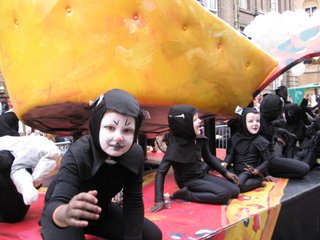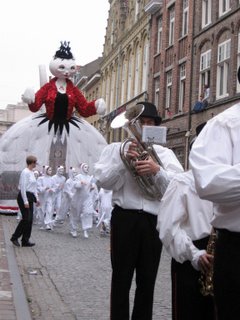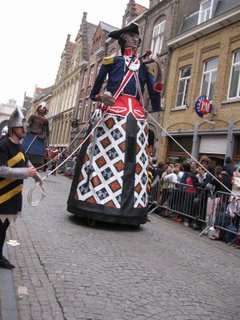 Yesterday the Canucks came over to Antwerpen and spirited us off to the Ypres (Ieper) Cat Festival.
Yesterday the Canucks came over to Antwerpen and spirited us off to the Ypres (Ieper) Cat Festival.Cat Festival you might wonder ...
Well I recently wrote of Ieper's cats but to recap: in the past, on the last day of the Annual Market in Ieper's Grote Markt there would be an excess of cats ... attracted by the mice attracted by the Market produce. Someone came up with the idea that the city jester should throw these excess cats to their death from the tower. Another story circulating says that Ieper burned its witches then threw their black cats from the bellfry ...
 Whatever the truth is, it was a bloodthirsty practice that came to an end back in 1817 and the Cat Festival rose up out of the ashes, complete with the long parade. It should be noted that belltowers and a present day jester throwing toy cats from the belfry also feature in this special day; one that ends with the burning of witches ...
Whatever the truth is, it was a bloodthirsty practice that came to an end back in 1817 and the Cat Festival rose up out of the ashes, complete with the long parade. It should be noted that belltowers and a present day jester throwing toy cats from the belfry also feature in this special day; one that ends with the burning of witches ... The parade began with the business procession which was better than expected after viewing the many work vehicles lined up at parade headquarters. The businesses handed out sweets and had woven brass bands and cat-like kids in the spaces between the big trucks and new cars.
 'Cats' rode 4-wheel motorbikes on 2 wheels, men breathed fire, a town cryer rode by on his horse advertising the witch burning and every now and again I turned my Canon EOS on the Belgians framed by their picturesque windows in the homes and businesses that lined the street of the festival ... to be developed at some later point. Meanwhile Gert took some good digital photographs so I'll illustrate using them.
'Cats' rode 4-wheel motorbikes on 2 wheels, men breathed fire, a town cryer rode by on his horse advertising the witch burning and every now and again I turned my Canon EOS on the Belgians framed by their picturesque windows in the homes and businesses that lined the street of the festival ... to be developed at some later point. Meanwhile Gert took some good digital photographs so I'll illustrate using them.The giants were there ... but of course, this is Belgium and every village and city has it's own history of giants. To quote from a knowing source: The traditional procession of giants encompasses an original ensemble of festive rituals. The event essentially consists of a procession of huge effigies of giants and animals within the scope of popular manifestations and ritual representations.
 These cultural expressions first appeared in the urban religious processions of sixteenth century western Europe and today still are emblems and provide a sense of identity to certain Belgian towns where they remain living traditions.
These cultural expressions first appeared in the urban religious processions of sixteenth century western Europe and today still are emblems and provide a sense of identity to certain Belgian towns where they remain living traditions. These giants are large-scale models measuring up to nine metres in height and weighing up to 350 kilos. They represent mythical heroes or animals, historical or legendary characters. Each expression follows a precise ritual and the giant is often related to the history, legend or life of the town.
Tot ziens ...
No comments:
Post a Comment